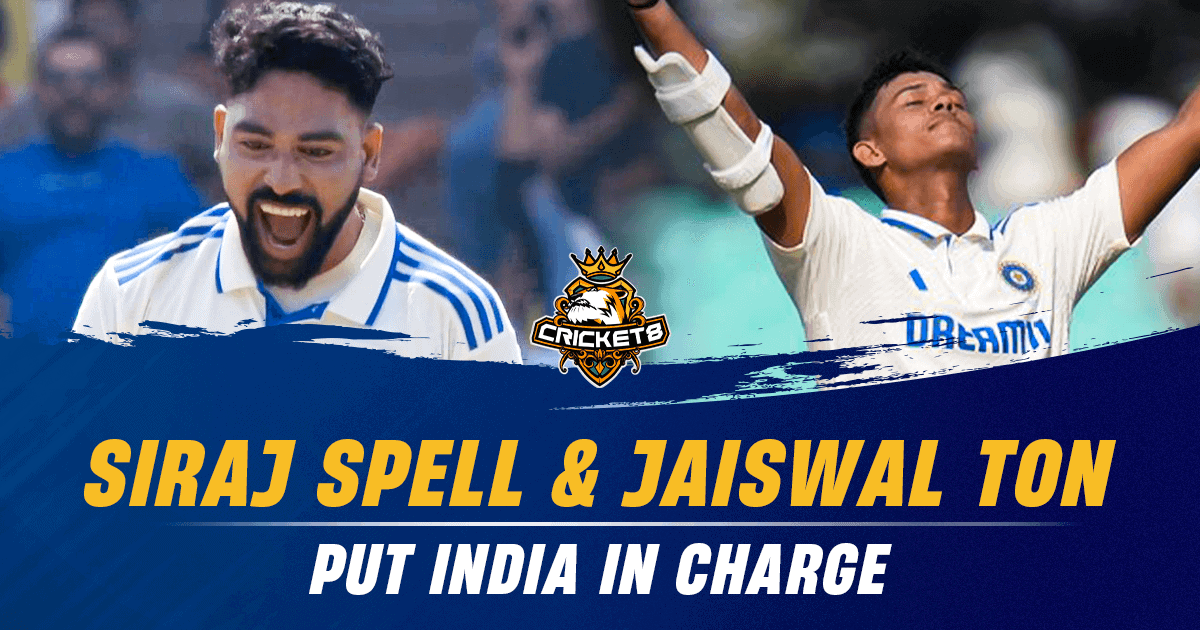Yashasvi Jaiswal scored the third century of his seven match Test career as India took control of the third Test against India. The left-hander was in his brutal best to rip through the visiting attack. Earlier in the day, Mohammed Siraj took four wickets to trigger a collapse for the English who lost their last five wickets under sixty runs. Team India would look to take a lead of 450+ runs in the second innings as they look to move ahead in this thrilling Test series.
Team Lineups
India made four changes to the team that comprehensively won the second Test at Vizag. KL Rahul is out with the quadriceps injury sustained in the first Test. With the selectors running out of patience with Shreyas Iyer, Sarfaraz Khan made his highly anticipated debut after waiting for a long time on the wings. The 26 year old has been the most run scorer over the past three seasons in the Ranji Trophy. Team India handed a debut to another youngster in the form of Druv Jurel.
The 23 year old wicketkeeper batsman was drafted into the team due to the inconsistent performances of Srikar Bharat. Jurel is a right handed batsman who is technically solid and can score runs easily. After his lacklustre show in the last Test match, Mukesh Kumar was omitted from the squad. The 30 year old pace bowler was released for the Ranji Trophy match. Mohammed Siraj was back to take his place in the Indian bowling attack.
Ravindra Jadeja is back after missing the second match with a knock. He replaced Axar Patel in the team. Virat Kohli was still unavailable due to personal reasons. Ravichandran had to withdraw himself from the team because of undisclosed personal reasons. India had to bowl the entirety of third day with their most experienced bowler missing from the attack.
England made one change to their team that was beaten by India in the first Test. Mark Wood was back to the team after sitting out the second Test match. Despite impressing with the ball in his first Test match, Sohaib Bashir had to drop to the bench for team combination. James Anderson kept his place in the playing eleven. The veteran pace bowler is closing on to the 600 wicket.
England
1. Zak Crawley 2. Ben Duckett 3. Ollie Pope 4. Joe Root 5. Jonny Bairstow 6. Ben Stokes (Cap.) 7. Ben Foakes (WK) 8. Rehan Ahmed 9. Tom Hartley 10. Mark Wood 11. James Anderson
India
1. Rohit Sharma (Cap.) 2. Yashasvi Jaiswal 3. Shubman Gill 4. Rajat Patidar 5. Ravindra Jadeja 6. Sarfaraz Khan 7. Dhruv Jurel 8. Ravichandran Ashwin 9. Mohammed Siraj 10. Jasprit Bumrah 11. Kuldeep Yadav
Indian skipper Rohit Sharma won the toss and had no hesitation to bat first. The pitch at Rajkot looks to be in prime condition for batting. There would be a hint of a turn from the third day. Otherwise, the flat deck in this ground is perfect for batting. There is a chance that the pitch would start to break after the third day, allowing the spinners to get some turn off the surface. The pace bowlers would have a tough time bowling on this flat pitch.
India has played two previous Test matches at Rajkot. They secured one win and a draw in the other match. In 2018, India beat West Indies by an innings and 278 runs. In the first match back in 2016, India had to settle for a draw against England. The average first innings score at this ground is 649 posted by India against the West Indies. The only instance of win at this ground was achieved by India while choosing to bat first at this ground. The average first score innings at this ground is 356. The average run rate is high with 3.58 runs scored in every over at this ground.
Fixture
India had won both of their Tests at Visakhapatnam prior to this game. The most recent Test match at this ground saw India beat South Africa by 203 runs. India and England have met on 133 occasions prior to this Test match. The visitors have the upper hand with 51 wins. The other 50 Test matches ended in a draw. India has emerged victorious on 32 occasions. In Tests in India, the hosts have won 23 games. Two of England’s 15 Test wins came in 2012, the last time a visiting side had toppled the Indians in their own backyard in a series. The first Test match in India’s history was played against England at Lord’s in June. 1932.
| Venue | The first day of the third Test match between India and England was played at Saurashtra Cricket Association Stadium in Saurashtra, Gujarat, India. |
| Date | The game started on Friday, February 15, 2024, at 10:00 a.m. local time. |
Captaincy & Tactics
In a riveting turn of events on the cricket field, the absence of R Ashwin due to personal reasons did not deter India’s determined push for victory in the Test match. The Indian bowling attack showcased their mettle by claiming a total of eight wickets in a session and a half, effectively nullifying the impact of Ben Duckett’s exceptional century on day two. The duo of Kuldeep Yadav and Mohammed Siraj orchestrated England’s downfall, instigating a dramatic turnaround in the match.
Facing a daunting task after conceding a first-innings lead of 126 runs, the Indian batsmen rose to the occasion, capitalizing on an unexperienced and faltering English bowling lineup. Yashasvi Jaiswal’s commanding century served as the centerpiece of India’s batting resurgence, culminating in a commanding lead of 322 runs by the end of the day’s play. This substantial advantage not only fortified India’s position in the match but also vindicated Ashwin’s unwavering confidence in their ability to mount a comeback on a challenging pitch.
The early phases of the match witnessed a flurry of wickets, with five of the twelve falling within the first hour of play. India strategically leveraged the advantageous conditions, with Jasprit Bumrah and Kuldeep spearheading the initial assault in Ashwin’s absence. The subtle hints of movement in the pitch provided an edge to the Indian bowlers, enabling them to halt England’s scoring momentum that had been buoyed by Duckett’s impressive innings the day before.
Kuldeep Yadav’s tactical adjustments and crafty bowling tactics stymied England’s batting line-up, leading to key breakthroughs including Duckett’s dismissal for 153. His finesse in manipulating the ball and inducing errors from the batsmen set the stage for India’s bowling domination, as they wrested control back from the free-scoring English batters.
Post lunch, Ravindra Jadeja and Mohammed Siraj displayed exceptional bowling prowess, outfoxing prominent English batsmen like Ben Stokes and Tom Hartley. The strategic brilliance of Jadeja’s unique angle of attack and Siraj’s reverse swing proficiency dismantled England’s lower order, culminating in a swift conclusion to their innings.

Subsequently, the Indian batsmen took the center stage, with Jaiswal and Shubman Gill forming a formidable partnership characterized by aggression and resilience. Jaiswal’s explosive batting display, punctuated by a flurry of boundaries and sixes, underscored India’s dominance with the bat. Gill’s composed innings complemented Jaiswal’s pyrotechnics, as he steadied the ship and ensured India’s commanding lead continued to swell.
Despite Jaiswal’s untimely retirement due to back pain, likely as a precautionary measure, India’s batting depth and resilience remained evident as they continued to assert their authority over the English bowlers. The renewed sense of purpose and determination within the Indian camp signaled a potential turning point in the series, portraying a team firing on all cylinders to secure a crucial victory.
In conclusion, India’s comprehensive display of skill, adaptability, and tenacity underscored their prowess in the Test match arena, setting the stage for a memorable triumph that epitomizes the spirit of cricket. The collective efforts of the team, both with the ball and the bat, exemplified their unwavering commitment to achieving success and overcoming challenges on the field.
Batting Analysis
On the third day of the gripping Test match held at the Niranjan Shah Stadium in Rajkot on 17 February, the contest between India and England took another exciting turn as the hosts continued to dominate proceedings with their stellar performance on both the batting and bowling fronts.
In a riveting display of skill and determination, the Indian bowlers led by Mohammed Siraj took center stage, showcasing their prowess by dismantling the English batting lineup. With Siraj scalping four crucial wickets, coupled with impactful contributions from Kuldeep Yadav, Ravindra Jadeja, Jasprit Bumrah, and the early departure of Ravichandran Ashwin due to personal reasons, India effectively restricted England to a total of 319 runs in their first innings. Ben Duckett’s resilient knock of 153, supported by Ben Stokes’ crucial 41, stood out amidst a flurry of wickets falling on the bowling

In response, India’s second innings began with a bang as Rohit Sharma led the charge but was dismissed by Joe Root after a brief yet impactful innings of 19 runs. The spotlight then shifted to the dynamic duo of Yashasvi Jaiswal and Shubman Gill, whose stellar partnership of 155 runs off 195 deliveries steered India towards a commanding position. Jaiswal’s scintillating knock, culminating in his third Test century off just 122 balls, underscored his batting prowess and marked his second century in the ongoing series. Noteworthy is Jaiswal’s impressive record of three centuries in merely seven test matches, highlighting his exceptional talent and consistency on the international stage.
Despite Jaiswal’s unfortunate retirement hurt due to back spasms, Gill continued to anchor the innings with resilience, notching up a well-earned half-century and remaining unbeaten at the close of play. The departure of Jaiswal, coupled with Gill’s steadfast presence at the crease, set the stage for an intriguing Day 4 play with India poised at 196/2 and holding a substantial lead of 322 runs over England.
The day also witnessed a significant moment as Indian stalwart Ravichandran Ashwin made a notable impact by dismissing Zak Crawley with a full-length delivery on the very first ball of the 14th over. However, Ashwin’s sudden exit from the ongoing Test match due to undisclosed personal reasons added a somber note to India’s performance, prompting the Board of Control for Cricket in India (BCCI) to request privacy and respect for the spinner during this challenging time.
Bowling Analysis
The day belonged to the Indian duo of Shubman Gill and Yashasvi Jaiswal, whose resolute batting performances steered India into a commanding position against the visiting English side. Following the early dismissal of skipper Rohit Sharma, Jaiswal and Gill orchestrated a game-changing partnership, surpassing the 150-run mark for the second wicket and laying a solid foundation for India’s dominance. Jaiswal’s scintillating knock of 104 off 133 deliveries, coupled with Gill’s unbeaten 65, propelled India to a formidable total of 196/2 at Stumps, extending their lead to a commanding 322 runs over England.
The trading of blows commenced early on Day 3, with England experiencing a brief moment of success before India wrestled back control of the match. Facing a formidable Indian bowling attack, England encountered a series of setbacks as they lost three key wickets in the first session, paving the way for a dramatic collapse in the following session. Kuldeep Yadav proved to be a thorn in England’s side, exhibiting unplayable spells and clinching two crucial wickets, while Mohammed Siraj’s standout performance saw him scalping four wickets to further destabilize the English batting lineup.
Notable among England’s struggles was the sublime innings of Ben Duckett, whose explosive century off just 88 balls showcased his attacking prowess and resilience at the crease. Duckett’s aggressive stroke play, highlighted by an impressive tally of 21 fours and two sixes, spearheaded England’s spirited response after India’s formidable first-innings total of 445 runs. However, India’s breakthrough moment arrived early on Day 3 when the seasoned Ravichandran Ashwin dismissed Zak Crawley, marking a historic milestone as he claimed his 500th Test wicket, joining the elite ranks of Indian cricketing legends.
The narrative took a somber turn for Team India as the news of Ashwin’s abrupt withdrawal from the match due to a family emergency cast a shadow over the proceedings, leaving the hosts with a formidable challenge ahead. Despite the setbacks, India’s resolve shone through as they navigated through the day’s play with resilience and determination, guided by standout performances from key players such as Jasprit Bumrah and debutant Dhruv Jurel.
Fielding Analysis
The Indians have been immaculate with their fielding in this Test. There performances are top notch in all of the fielding parametres. The hosts have completed all the catches that were offered. Yashasvi Jaiswal took a fine catch to dismiss Joe Root. Rohit Sharma, Jasprit Bumrah also pouched the ball safely when the chances came their way. Eventually the English batters collapsed before the brilliant attack of the Indians.
The English fielders did not had much to day as Jaiswal took the initiative in the later part of the day. Rehan Ahmed took an easy catch to dismiss Rajat Patidar. The English fielders need to deliver their best if they want to salvage a draw from this position.
Key Performances
In the absence of the great Ravichandran Ashwin, Mohammaed Siraj took the bowling mantle of Team India. The right-arm pacer bowled with a lot of verve and accuracy to claim four wickets in his bowling spell. Ravindra Jadeja also bowled a brilliant spell. The centurion in the first innings claimed two wickets for 51 runs in his 10 over spell. Kuldeep Yadav made a brilliant comeback after his failure in the previous day.

The left-arm wrist spinner displayed all the elements of his arsenal to secure two scalps. Jasprit Bumrah also bowled brilliantly post lunch, but he has only one wicket to his name for his valiant effort. Ben Duckett scored almost half of the England’s first innings total. The left-hander posted a magnificent 153 off 151 balls to keep his side in the game. Ben Stokes tried his ultimate best stop the rot. But English skipper was sent back by Ravindra Jadeja to the pavillion. Ollie Pope played well for his 39, but none of other English batsmen made enough contribution as India took a huge lead.
Yashasvi Jaiswal scored another blistering century full of entertainment. The young Uttar Pradesh opener had to leave the field after feeling a back strain but tormented the bowlers during his stay. Jaiswal stormed to his 3rd Test century in just 98 balls. He found the perfect partner in Shubman Gill who batted like a seasoned veteran for his fifty. Gill would start the 4th day with his score at 56. Joe Root and Tom Hartley got one wicket apiece. Mark Wood and James Anderson struggled to make their mark in the face of a Jaiswal onslaught.
Day Result
India were 322 runs ahead in their second innings at the end of day’s play. The hosts still have eight wickets in hand.
Brief Scorecard
| India First Innings: 445/10 (130.5 overs) | England First Innings: 319/10 (71.1 overs) | India Second Innings: 196/2 (51 overs) |
| Rohit Sharma 131 (196) | Ben Duckett 133 (118) | Yashasvi Jaiswal 104 (133) |
| Ravindra Jadeja 112 (225) | Ben Stokes 41 (89) | Shubman Gill 65 (120) |
| Mark Wood 4/114 (27.5 overs) | Mohammed Siraj 4/84 (21.1 overs) | Tom Hartley 1/42 (15 overs) |
| Rehan Ahmed 2/85 (22 overs) | Ravindra Jadeja 2/51 (10 overs) | Joe Root 1/48 (14 overs) |
Day Highlights
Day Wrap-Up
The Indian bowlers performed magnificently to ensure a huge lead after the first innings of their opponents. Mohammed Siraj took four wickets to trigger a late English collapse. Then Yashasi Jaiswal scored his second century in consecutive Tests to put India in the driving seat. The Indians would look to get their lead past the 450 mark to take the game away from the visitors. England need to take a few wickets in the first session if they want to stay in this Test match.




